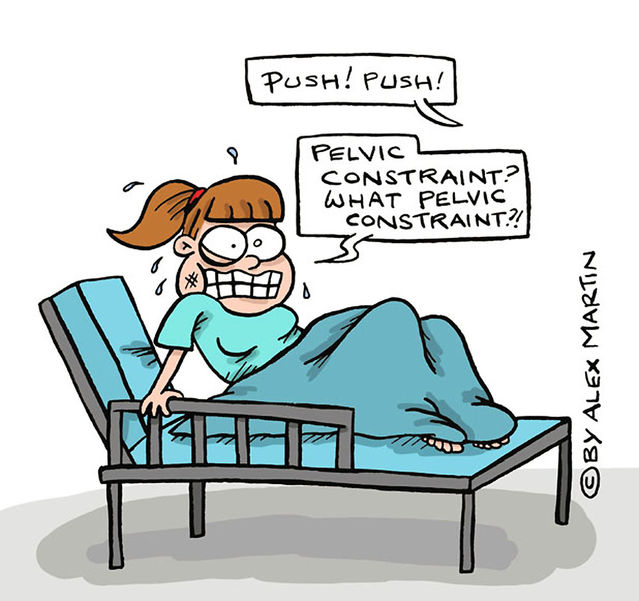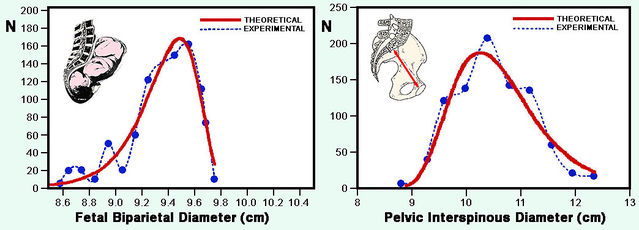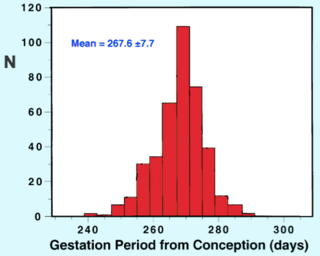Pregnancy
Why Must Childbirth Be So Challenging?
The evolutionary explanation for our big heads and small pelvises.
Posted November 19, 2015

Human birth is far more challenging than that of other primates. In 1960, anthropologist Sherwood Washburn proposed a widely accepted explanation for the tight squeeze a baby experiences passing through the birth canal:
In man adaptation to bipedal locomotion decreased the size of the bony birth-canal at the same time that the exigencies of tool use selected for larger brains. This obstetrical dilemma was solved by delivery of the fetus at a much earlier stage of development.
Washburn thus invoked a trade-off between adaptations for upright walking and development of a large brain. But birth at “a much earlier stage” is only true of the brain: In great apes (orangutans, gorillas, chimpanzees) the newborn’s brain is already about half as big as in adults, whereas in humans it is barely more than a quarter. I concluded in a 1983 review that more brain growth occurs after birth in humans because the birth canal constrains the newborn’s brain size. As anatomist Vyvyan Howard succinctly stated in 1981: “By being born earlier, the fetal head...can pass through the maternal pelvis and then continue developing in the postnatal period.” However — despite similar pregnancy lengths — human newborns are almost twice as big as those of great apes, so overall fetal growth is actually greater in humans and the brain is larger at birth.
Tortuous passage through the pelvis
The birth canal In a woman’s pelvis is convoluted. Its inlet is widest from side to side, while its outlet is largest from back to front. Karen Rosenberg showed in 1992 that safe passage of the newborn through the pelvis requires a 2-phase turning sequence. As the infant's head enters the inlet, it is already rotated so that its long axis is oriented side-to-side, not back-to-front as is typical in other primates. Passing on through the pelvis, the baby's head then rotates further to fit the longer front-to-back axis of the outlet. So the newborn typically faces toward the mother’s back on emergence. Other primates usually lack rotation and the baby passes through the pelvis with its head facing forward. In fact, it is not only the human newborn’s large head that makes birth challenging. Its shoulders are also quite wide compared to the birth canal, so additional juggling is needed to avoid jamming.
![Birth canal image from Internet Archive Book Images [no restrictions] and Henry Vandyke Carter [Public domain], both via Wikimedia Commons. Birth canal image from Internet Archive Book Images [no restrictions] and Henry Vandyke Carter [Public domain], both via Wikimedia Commons.](https://cdn.psychologytoday.com/sites/default/files/styles/image-article_inline_full_caption/public/field_blog_entry_images/Pelvic%20Constraint%20Combo.jpg?itok=YOG-9C5k)
An alternative interpretation
A 2012 paper by Holly Dunsworth and colleagues challenged the long-accepted obstetrical dilemma hypothesis, suggesting instead that an upper limit on the mother's energy turnover is the primary constraint on pregnancy duration and newborn state. Their alternative “energetics-of-gestation-and-growth” hypothesis proposes that human birth occurs when the mother’s energy turnover reaches the maximum sustainable level. This interpretation is backed by graphical representation of energy costs of the human mother during pregnancy and after birth (mainly using data from a 2005 paper by Nancy Butte and Janet King). But that only shows that maternal energy costs approach a theoretical maximum at the time of birth; it does not directly reveal a causal relationship. (See my July 12, 2013 post The Stork-and-Baby Trap, discussing the crucial distinction between correlation and causation.)
Dunsworth and colleagues certainly provided an interesting new perspective on human birth timing, covering several aspects beyond the scope of this commentary. Their reference to the mother’s energy turnover is undeniably valuable, but — as Pat Shipman noted in a thoughtful 2013 commentary — the obstetrical and energetic hypotheses are not mutually exclusive. Accompanying media commentaries unfortunately suggested that the crucial importance of the pelvic constraint in human birth has been “refuted”. As Shipman rightly observed: “The obstetrical hypothesis is not defunct; it is simply under question.”

Natural selection because of the pelvic constraint
In a little-known paper published in 1981, Vyvyan Howard provided convincing evidence for a pelvic constraint in human birth, introducing the concept of “genetic pruning”. As a general rule in biology, linear dimensions such as body heights in men conform to a “bell curve” (normal distribution) with a central peak corresponding to the mean value and a symmetrical decline in frequencies on either side. Howard proposed that selection against large or small dimensions could lead to truncation of a normal distribution, resulting in negative or positive skew. As he showed, dimensions of birds’ eggs, which are incompressible once formed and then have to pass through a narrow stretch of the oviduct, provide an interesting illustration. The Hawaiian goose has the highest egg-to-body-weight ratio among geese, and egg binding has been a common cause of death in captive breeding. Egg diameter (critical for passage through the oviduct) shows a negative skew, reflecting pruning of larger egg sizes. By contrast, egg length is both more variable and more symmetrically distributed.

Applying the same approach to the mechanics of human birth, Howard found that, as expected, the distribution for newborn head size was truncated at the upper end, whereas pelvic canal size was contrastingly truncated at the lower end. This clearly indicates that natural selection through obstructed labour — usually fatal without medical intervention — pruned frequencies of large newborn heads and small pelvic canals. In fact, distributions for human pregnancy duration also show truncation of higher values.

Truncated distribution for pregnancy durations inferred using basal body temperature (after Döring 1962).
This is, for example the case with a 1962 paper by Gerd Döring, who estimated conception times for almost 400 pregnancies from basal body temperature. Longer pregnancies generally lead to larger neonates with bigger brains, so natural selection should tend to eliminate them. Note, however, that in this case truncation of higher values would also be expected with the metabolic constraint hypothesis.
Evolutionary biologists Barbara Fischer and Phillipp Mitteroecker recently supplied complementary evidence from an analysis of relationships between human pelvis shape, stature and head size. Analyses of data from multiple landmarks revealed a previously unrecognized relationship: Large-headed women, who are more likely to give birth to newborns with large heads, have a pelvic canal shape permitting easier passage at birth. It was also found that women of short stature, who are generally at greater risk of a mismatch between the newborn’s head and pelvic dimensions, have a rounder inlet, similarly facilitating birth.
Why does human birth push the limits?
As Fischer and Mitteroecker noted, it is puzzling that evolutionary change has not reduced the significant mortality risk that women face in childbirth. Even without changes in the pelvis, the challenges of human birth could, for instance, be radically lessened by minor reduction of pregnancy duration or some other adaptation decreasing newborn size. Why does childbirth evidently push the limits for both pelvic dimensions and maternal energy turnover? In fact, available evidence indicates that development within the mother’s womb is favoured as far as possible over development of the suckled infant after birth. Perhaps it is simply more efficient to transfer nutrients directly across the placenta, instead of first converting them to milk that the infant must digest. Selection may also maximize time in the womb because it provides protection and environmental stability. Whatever the reason, human birth clearly occurs at a point where the baby will only just pass through the pelvic canal. When that 2012 paper was published, ScienceDaily quoted Dunsworth as saying “Mom’s energy is the primary evolutionary constraint, not the hips”. But it seems far more likely that the pelvis constrains the timing of birth, whereas the mother’s energy turnover has merely been adapted to peak as birth approaches.
References
Döring, G.K. (1962) Über die Tragzeit post ovulationem. Geburtshilfe & Frauenheilkunde 22:1191-1194.
Dunsworth, H.M. & Eccleston, L. (2015) The evolution of difficult childbirth and helpless hominin infants. Annual Review of Anthropology 44:55-69.
Dunsworth, H.M., Warrener, A.G., Deacon, T., Ellison, P. & Pontzer, H. (2012) Metabolic hypothesis for human altriciality. Proceedings of the National Academy of Sciences U.S.A.109:15212-15216.
Butte, N.F. & King, J.C. (2005) Energy requirements during pregnancy and lactation. Public Health Nutrition 8(7A):1010-1027.
Fischer, B. & Mitteroecker, P. (2015) Covariation between human pelvis shape, stature, and head size alleviates the obstetric dilemma. Proceedings of the National Academy of Sciences U.S.A. 112:5655-5660.
Howard, C.V. (1981) Experimental and theoretical evaluation of size distributions: Their evolution and the phenomenon of "genetic pruning". Stereologica Iugoslavica 3, Suppl. 1:79-88.
Martin, R.D. 1983. Human Brain Evolution in an Ecological Context (52nd James Arthur Lecture on the Evolution of the Human Brain). American Museum of Natural History, New York.
Rosenberg, K.R. (1992) The evolution of modern human childbirth. Yearbook of Physical Anthropology 35:89-124.
Rosenberg, K.R. & Trevathan, W.R. (1996) Bipedalism and human birth: The obstetrical dilemma revisited. Evolutionary Anthropology 4:161-168.
Rosenberg, K.R. & Trevathan, W.R. (2001) The evolution of human birth. Scientific American 285(5):72-77.
Shipman, P. (2013) Why Is human childbirth so painful? Having babies isn’t easy — and the standard explanation may be wrong. American Scientist 101:426-429.
Washburn, S.L. (1960) Tools and human evolution. Scientific American 203(3):3-15.




